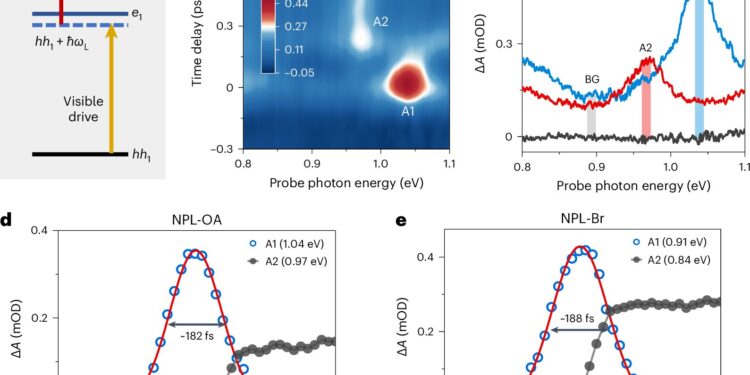Observation of Floquet states in NPLs. Credit: Photonics of nature (2024). DOI: 10.1038/s41566-024-01505-z
Solution-processed semiconductor nanocrystals are also called colloidal quantum dots (QDs). Although the concept of size-dependent quantum effects has long been known to physicists, sculpting the theory into real nanodimensional objects remained impossible until the discovery of QDs. The size-dependent colors of QDs are essentially naked-eye and ambient-condition visualizations of the quantum size effect.
In recent years, researchers around the world have been searching for fascinating quantum effects or phenomena using the QD material platform, such as single photon emission and manipulation of quantum coherence.
Floquet states (i.e. photon-dressed states) are widely invoked to explain quantum phenomena related to the coherent interaction between the light field and matter. However, direct observation of these Floquet states represents an experimental challenge.
For example, only very recently have researchers reported experimental signatures of Floquet-Bloch bands in black phosphorus (a model narrowband semiconductor) interacting with mid-infrared pulses using complex time- and angle-resolved photoemission spectroscopy. In such studies, samples were almost exclusively housed in low-temperature, high-vacuum environments, and excitation fields were tuned to the infrared, terahertz, or even microwave regions to avoid damaging the samples.
In a study published in Photonics of natureProfessor Wu Kaifeng and colleagues from the Dalian Institute of Chemical Physics, Chinese Academy of Sciences, have reported the first direct observation of Floquet states in semiconductors using all-optical spectroscopy in the visible to near-infrared region under ambient conditions.
Characterization of colloidal CdSe NPLs. Credit: Photonics of nature (2024).
The researchers adopted the quasi-two-dimensional colloidal nanoplatelets developed in the last decade. The powerful and atomically precise quantum confinement in the thickness dimension drives interband and intersubband transitions in the visible and near-infrared regions, respectively. The levels involved in these transitions naturally form a three-level system.
A visible sub-bandgap photon transforms a heavy hole state (|hh1⟩) into a Floquet state of the same parity as the first quantized electronic state (|e1⟩), allowing this Floquet state to be probed by a near-infrared photon through its transition to the second quantized electronic state (|e2⟩).
Moreover, while transiently populated Floquet states were often assumed to vanish outside the temporal overlap of the pump and probe pulses, the researchers directly observed the dephasing of the Floquet state into a real population of |e1⟩ within hundreds of femtoseconds. All experimental observations in this study are corroborated by quantum mechanical simulations.
“Not only does this study provide a direct all-optical observation of Floquet states in semiconductor materials, but it also reveals the rich spectral and dynamical physics of Floquet states that can be exploited to dynamically control optical responses and coherent evolution in condensed matter systems,” said Professor Wu.
Since the current demonstration is performed for colloidal materials under ambient conditions, it will expand the scope of Floquet engineering, which currently focuses on tailoring the quantum and topological properties of solid-state materials, to coherently control surface/interface chemical reactions through a non-resonant light field.
More information:
Observation of Floquet states and their phase shift in colloidal nanoplatelets driven by visible pulses. Photonics of nature (2024). DOI: 10.1038/s41566-024-01505-z
Provided by Chinese Academy of Sciences
Quote: Researchers observe Floquet states in colloidal nanoplatelets driven by visible pulses (2024, August 21) retrieved August 21, 2024 from
This document is subject to copyright. Apart from any fair dealing for the purpose of private study or research, no part may be reproduced without written permission. The content is provided for informational purposes only.



